12 Remarkable Women in Chinese History
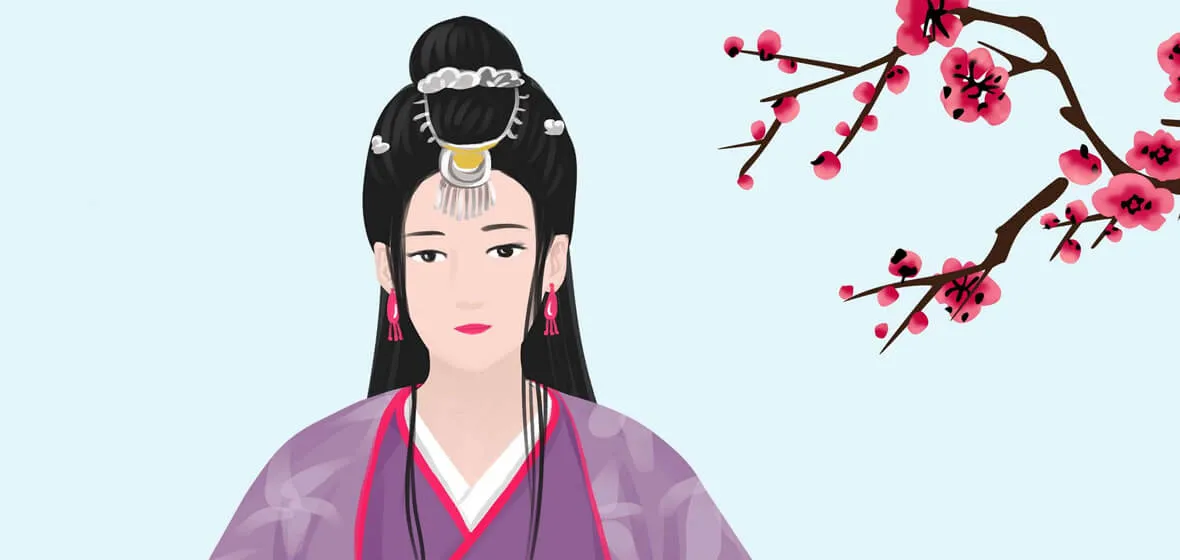
Women hold up half the sky.
-Mao Zedong
Historically, China was a patriarchal society where men made all of the decisions. Women were inferior to men. Women’s roles were in the home. Their job was to look after their husbands and raise the children. Despite the jobs discrimination in ancient China, women excel in all fields: there were female generals, a female Kungfu master and even a female monarch! There was even a pirate queen that commanded 1800 ships and 80,000 soldiers.
We have listed 12 remarkable women and their stories below:
1. Fu Hao (c.1278 BCE–c.1245 BCE)
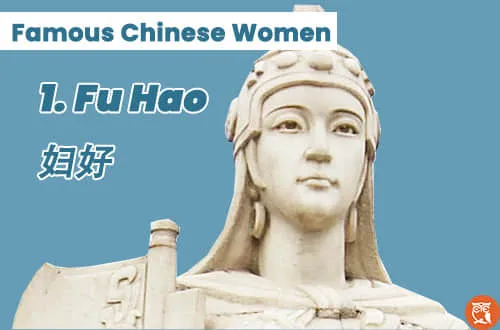
Fu Hao (also known as Lady Hao) was a wife of King Wu Ding. Fu Hao was a general in command of Shang armies. The weapons in her tomb also suggest this. Fu Hao had up to 13,000 troops serving under her and won many battles. She died around 1200 BCE. In 1976, the tomb of Fu Hao was discovered. Some of the jade objects had been collected by Fu herself and were already antiques when she died. She was also buried with a large quantity of weapons including great battle axes. Fu Hao also performed religious ceremonies. Artifacts of inscriptions on tortoise shells bear the words “Prepared by Fu Hao”. The evidence proves that Queen Fu Hao was also in charge of divination rites.
Major Accomplishments:
- First Female General.
- Led the earliest recorded large ambush in Chinese history.
2. Ban Zhao (c.48–117 CE)
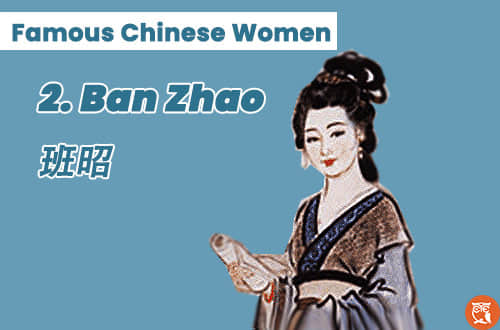
Ban Zhao was born into a wealthy and educated family. At the age of 14, she married Cao Shishu, who lived in her hometown. She was recognized as “Venerable Madame Cao” in the court. Although her husband died young, leaving her with kids to raise on her own, she never remarried again as she chose to dedicate her time to scholarly pursuits. This, in turn, led to her success as a philosopher and historian, as well as her most famous work, titled “Lessons for Women.” Ban Zhao composed this piece when she was more than fifty-four years old. For many, Ban Zhao’s Lessons for Women stands out as the antithesis of modern feminism. Indeed, scholars criticized Ban for her discriminatory ideas. However, even in modern times, many scholars recognized her significance and praised her intelligence.
Major Accomplishments:
- First female philosopher, scholar, and poet.
- A major contributor to the Book of Han, one of the best-known Chinese history books ever written that covered the Han dynasty history.
- Her work, “Lessons for Women”, has become the most popular treatise on the education and conduct of women in ancient China.
3. Cai Wenji (C.177 CE- death date unknown)
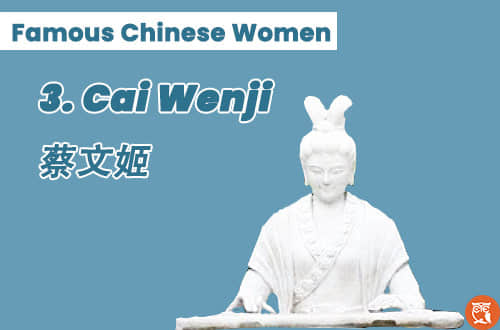
Cai Wenji ‘s formal name is Cai Yan, Wenji is her style name. She was born into a family of scholars. Her father, Cai Yong, was an expert in calligraphy, music, mathematics and astronomy. She married Wei Zhongdao in 192 but her husband died shortly after their marriage. Cai was captured by the Xiongnu and taken back as a prisoner to the northern lands. During her captivity, she became the wife of the Xiongnu chieftain, and 12 years later, the warlord Cao Cao, who had become the de facto head of government in China, paid a heavy ransom in the name of Cai’s father. Cai was released and she returned to her homeland but left her children behind in Xiongnu territory. The reason Cao Cao wanted her back was that her father was a good friend of Cao Cao. Cai married again, this time to a government official named Dong Si. Cai, like her father, was an established calligrapher of her time, and her works were often praised along with her father’s. Her poems were noted for their sorrowful tone, parallel to her hard life. The famous guqin piece Eighteen Songs of a Nomad Flute is traditionally attributed to her, although the authorship is a perennial issue for scholarly debate.
Major Accomplishments:
- Poet and musician.
- Established Calligrapher.
- Composed guqin piece Eighteen Songs of a Nomad Flute.
4. Princess Pingyang (C.600-623 CE)
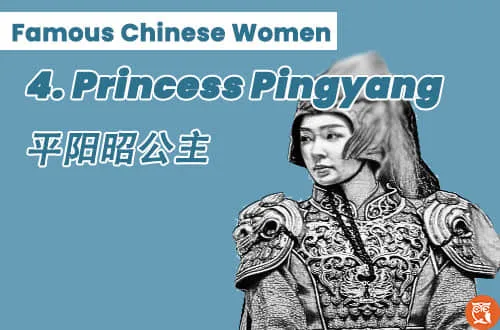
Born in 600 CE in Taiyuan in northern China’s Shanxi province, Princess Pingyang was the third daughter of Li Yuan, an influential Sui Dynasty military commander. At that time, China was under the rule of emperor Yang of Sui Dynasty, the emperor was a harsh and unfair ruler. In 617, Li Yuan started a rebellion against the Sui Dynasty. Pingyang sold her property and joined her father’s rebellion. She organized an “Army of the Ladies”. She took on and defeated other rebel groups, as well as bandits, raiders, and brigands that were terrorizing the countryside. Her army soon became a respectable fighting force of over 70,000 warriors. When Pingyang conquered a town or city, she forbade her men from looting, raping, and plundering; instead her army would bring food and drink to the oppressed citizens. Quickly, Li Yuan captured Chang’an, the capital, and founded the Tang Dynasty in 618. Sadly, Princess Pingyang died in 623. Her father gave her a military burial fit for a general, complete with a band playing badass war music.
Major Accomplishments:
- Participation in Tang Dynasty's Founding.
- Commander of “Army of the Ladies”.
5. Wu Zetian (625-705 CE)
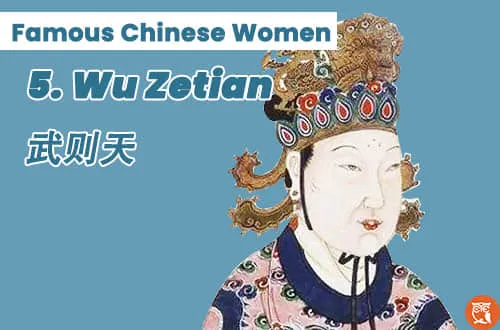
Major Accomplishments:
Empress Wu Zetian was the daughter of a senior government official who also owned a timber business. Her mother, Lady Yang, hailed from the very powerful and affluent Yang family. At the age of 14, she was selected by Emperor Taizong to be his junior palace concubine – a position she served until Taizong’s death in 649. While in the court of the emperor, she served as a secretary. This position of hers allowed her to stay abreast of current matters, court politics and diplomacy – subjects that would prove very useful when she came of age. Following Taizong’s death, Li Zhi – the deceased emperor’s youngest son – was crowned Emperor Gaozong of Tang. Fancying Wu Zetian, the new emperor brought Wu from a Buddhist convent (Ganye Temple) to his court to make her his favorite concubine. She gradually became Emperor Gaozong’s most trusted confidant.
In 683, Wu took power when Gaozong died. In 690, Wu proclaimed herself Empress Wu Zetian, ruling under her own authority. In 704 Wu Zetian was forced to abdicate in favor of her son Zhongzong. Despite her heinous actions to attain and maintain power in a Male-Supremacy Society, Wu Zetian was still widely regarded as a highly capable ruler who effectively ruled China and made the dynasty prosper.
- The only female monarch in China.
- Drastically expanded Chinese borders and influence.
- Reformed government service, allowing for stable growth.
- Revitalized the 7th-century Chinese economy.
6. Shangguan Wan’er (664-710)
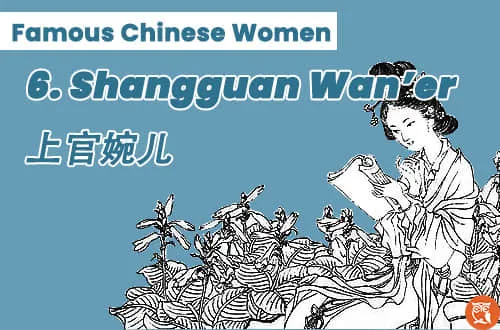
Shangguan Wan’er was the granddaughter of the court poet Shangguan Yi, who served under Emperor Taizong and Emperor Gaozong. Her father and grandfather were executed under Emperor Gaozong for planning to topple Empress Wu Zetian. Shangguan Wan’er and her mother were forced to enter into imperial servitude. At the palace, she received an excellent education in the classics and literature. Her intelligence eventually attracted the attention of Empress Wu Zetian. The Empress kept her as her trusted aide. Wan'er served Wu Zetian from being the queen, the empress dowager, and later the emperor, and wrote all of her imperial edicts. She was also a brilliant poet, as well as serving as a judge in the academy to select intelligent scholars, where she significantly influenced the literature of that period.
Major Accomplishments:
- Accomplished poet
- The first and only female premier in ancient China
7. Li Qingzhao (1084 – 1155)
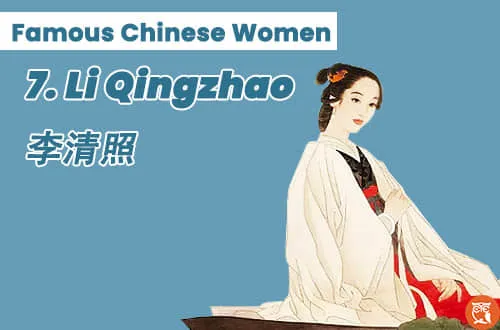
Li Qingzhao was born into a literary family, and her father was a scholar official who studied poetry under the famous poet Su Shi. Her mother was also from a family of scholars. As a result, she received a comprehensive literary education when she was just a young girl. At the age of 18, Li Qingzhao married Zhao Mingcheng, a noted antiquarian from an educated family who shared her passion for literature, books, inscriptions, artifacts and collections.
Li’s poetry, rather sadly, reflects the tumultuous historical period in which she lived, and changed as her life was transformed through a series of traumatic events – reflecting her own journey from happiness to despair against the backdrop of war and conflict. She wrote the famous verse “In life be a hero among men, In death, a champion among ghosts” (生当作人杰,死亦为鬼雄). This has been a commonly quoted verse to praise those heroic figures who lost their lives to defend their faith.
Major Accomplishments:
- One of the greatest and most talented literary figures in Chinese history.
- Helped to edit Jin Shi Lu (Record of Bronzes and Stones 金石录), a posthumous work by her husband Zhao Mingcheng.
8. Qin Liangyu (1574–1648)
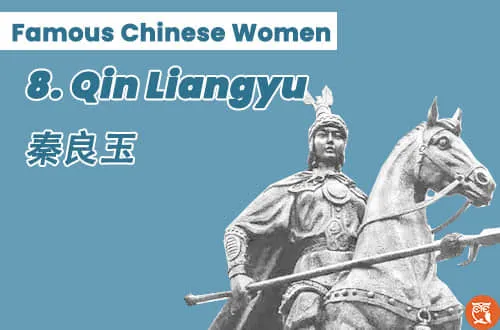
Qin Liangyu was born in Zhongzhou, which is in present-day Zhong County, Chongqing, to ethnic Miao parents. She trained in the martial arts from an early age and was an excellent mounted archer who often practiced archery with her brothers. In addition to being skilled in the arts of war, Qin was also well-read and a good strategist.
In 1595, Qin Liangyu married Ma Qiancheng, the tusi (local governor) of Shizhu County, and accompanied him in minor battles against local warlords in the southwestern border of the Ming Empire. They had a good marriage and he often sought her advice. In 1599, when Yang Yinglong started a rebellion in Bozhou (present-day Zunyi, Guizhou), Ma Qiancheng brought 3,000 riders with him to suppress the revolt while Qin Liangyu brought an additional 500 to support her husband. They successfully quelled the rebellion and destroyed the rebels' camps. In 1613, her husband was arrested because he offended a court eunuch and he died in prison. At his death, Qin Liangyu took over his post, and those under her command were known as the White Cavalry. In 1620, she was accompanied by her brothers as they rushed to the northeastern frontier to help the Ming military effort in Shenyang. Qin Liangyu was the only female general to be officially listed in the biographies of generals of Chinese dynastic historical accounts, recognized for her loyalty and bravery.
Major Accomplishments:
- Only Female General recorded in the generals’ section of Chinese history.
- Inventor of the white pole spear with front bladed iron hook and rear iron ring.
9. Yan Yongchun (Yim Wing-chun) (c.1735-c.1795)
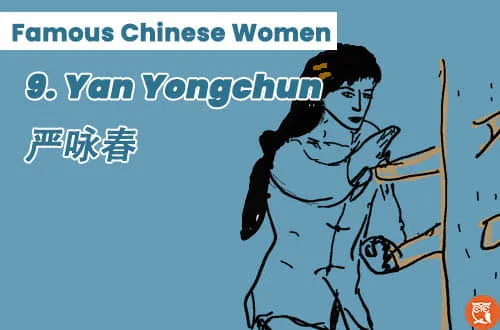
The exact birth date of Yan Yongchun was not recorded, we only know that she lived during the reign of Qianlong emperor from 1735 to 1795. She was born in Guangzhou Province in southern China. To avoid a legal battle, her father took her to live in Sichuan province in southwestern China. They lived over a Tofu shop and got to know the nun Wu Mei aka Ng Mui – who was one of the Shaolin sect survivors. At the age of 15, Yan was molested by a local thug. The nun took pity on Yan and taught her the new system developed specifically with a woman's needs in mind – it emphasizes using technique over power to subdue a stronger opponent.
Yan was thus able to beat the man and became a famous fighter and was never defeated. She taught her husband the new Kungfu style and her husband named it Yongchun (Wing Chun). They later returned to Guangdong and taught Yongchun to other disciples. Bruce Lee first trained in Yongchun as a young man before developing Jeet Kune Do later in life.
Major Accomplishments:
- Founder of the Yongchun (Wing Chun) martial arts system.
10. Zheng Yisao (aka Ching Shih, Cheng I Sao, Ching Yih Saou or Mrs Cheng) (1775-1844)
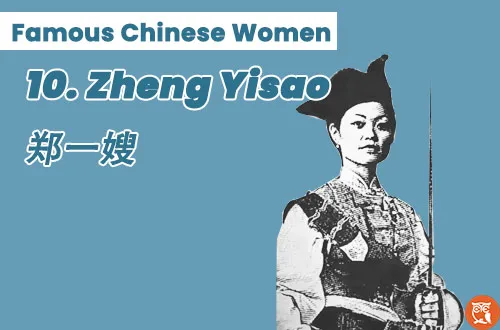
Zheng Yisao, born Shi Yang, was born into a poor fishermen family in Guangdong area. She was sold into prostitution at a young age. In 1801, the powerful pirate captain Zheng Yi asked for her hand in marriage and bought her freedom. Hence, she was called Zheng Yisao, which means “wife of Zheng Yi”. In 1804, they established a confederation of six pirate leaders, each commanding a fleet and all under their supreme command. Zheng Yi drowned in a typhoon in 1807. Without hesitation Zheng Yi Sao assumed leadership – surprisingly without any uproar –and soon she had earned the nickname “Dragon lady”. She took over command of his 1,800 ships, known as the Red Flag Fleet, and over 40,000 men (or 80,000 according to some sources). Her authority was respected, and her strict code of laws was obeyed by the men. Attempts by Qing Dynasty officials, the Portuguese Navy, and the East India Company to bring Zheng Yisao down were unsuccessful, and she gained the notoriety of becoming arguably the world's most successful pirate. In the year 1810, Zheng Yisao met with Qing China army officials to negotiate the terms of her surrender. All of her crew was pardoned, and she managed to get 20 to 30 ships and a crew to enter the salt trade. After retirement, it is believed that she may have lived out the rest of her years as the proprietor of a gambling den. Undoubtedly, she was one of the most successful pirates to have ever lived.
Major Accomplishments:
- Pirate Queen of the Qing Dynasty.
- Defeated Chinese naval fleets guarding the river delta between Macao and Canton.
11. Empress Dowager Cixi (1835-1908)
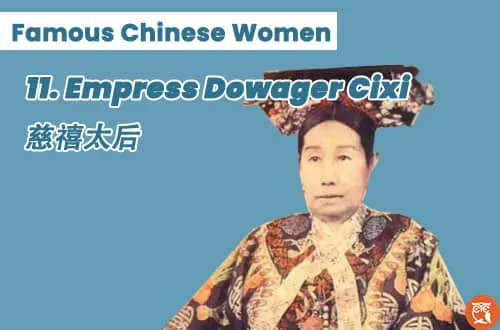
Empress Dowager Cixi, family name Yehenara, was born into a government employee family from the ruling Manchu minority. At age 16, she was brought to the Forbidden City to join Emperor Xianfeng's harem. When Xianfeng died in 1861, Cixi's five-year-old son was his only male heir and became the emperor Tongzhi, making her the "empress dowager" and a regent ruler. This earned her the title Cixi, meaning "empress of the western palace." Cixi gave up the regency when her son turned 17, but Tongzhi died two years later and Cixi became a regent again, this time for her three-year-old nephew Guangxu. She died on November 15, 1908, a day after Guangxu Emperor’s death. Prior to her death, on November 14, 1908, she enthroned Puyi who was the last emperor of China.
For many decades, Dowager Empress Cixi was generally portrayed as a power-hungry ruler who did everything possible to consolidate her hold over the imperial dynasty, including executing anyone that opposed her. But in fact, Cixi wanted to modernize China to boost its economy in order to avoid total submission to the West, as well as Japan, which had become a serious threat to China. Cixi initiated reforms that shook up all aspects of Chinese life. Marriages between Han and Manchu partners were legalized. Foot-binding, a custom long practiced on Han girls, was banned. Freedom of the press was expanded.
Major Accomplishments:
- Initiated a number of reforms (i.e. the Tongzhi Restoration) that were aimed at modernizing China as a whole.
- Order to build China’s first rail line, the Beijing-Wuhan railway.
- Abolished barbaric tortures (like Death by a Thousand Cuts) as well as forbidding the practice of foot-binding.
12. Lin Huiyin (1904-1955)
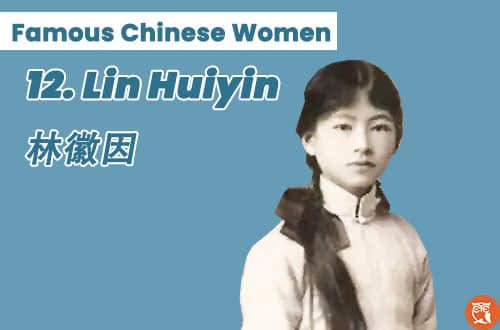
Lin Huiyin was born on June 10, 1904 in China. Also known as Lin Whei-yin and Phyllis Lin, she is notable as the first woman in modern Chinese history to have a career as an architect. She was able to receive a formal education due to being part of a wealthy family. She furthered her education in the University of Pennsylvania and Yale University.
She is known to be the first female architect in modern China and her husband the famed "Father of Modern Chinese Architecture" Liang Sicheng, both of whom worked as founders and faculty in the newly formed Architecture Department of Northeastern University in Shenyang in 1928 and, after 1949, as professors in Tsinghua University in Beijing. She is particularly remembered for overseeing the restoration of multiple Chinese historical sites. She also helped design China's national flag, as well as the Tiananmen Square Monument to the People's Heroes.
Major Accomplishments:
- First female architect in modern China.
- Author of You are the April Days of the World which includes prose, fiction and letters.
- Co-authored "History of Chinese Architecture" with Liang Sicheng.
- Involved in the design of the National Emblem of the People's Republic of China and the Monument to the People's Heroes located in the Tiananmen Square.

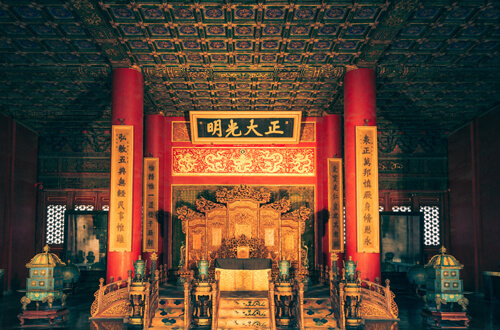 Top 10 Greatest Emperors
Top 10 Greatest Emperors 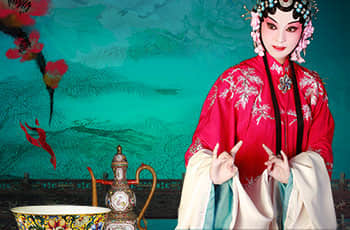 10 Famous Peking Opera Artists
10 Famous Peking Opera Artists  Understanding Chinese People and Culture
Understanding Chinese People and Culture  China Facts
China Facts